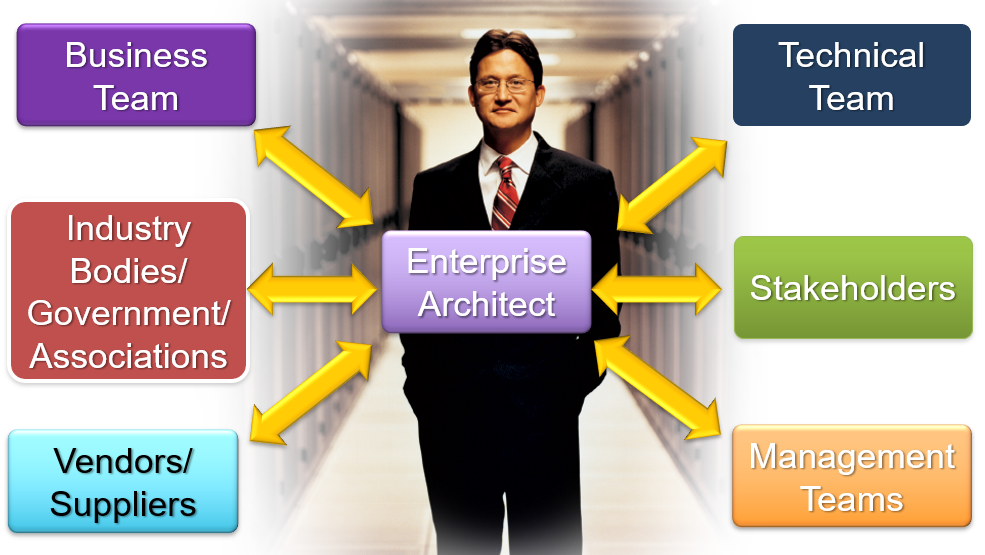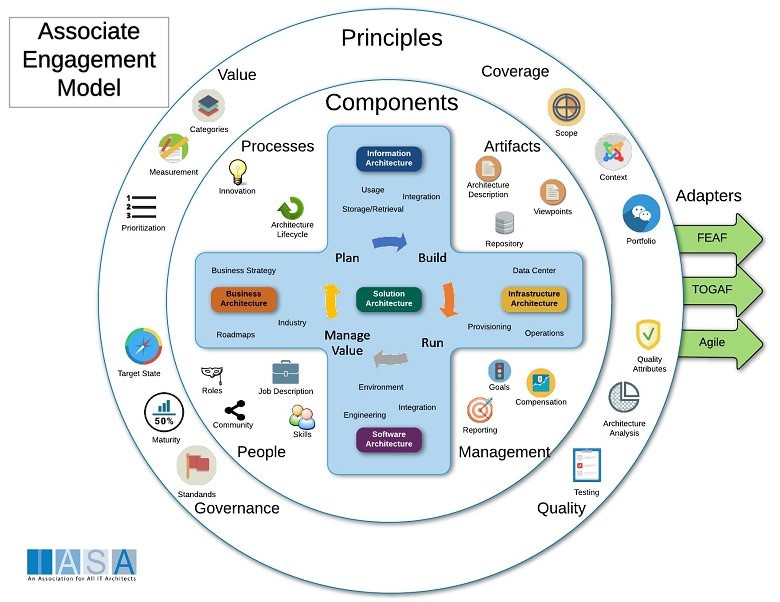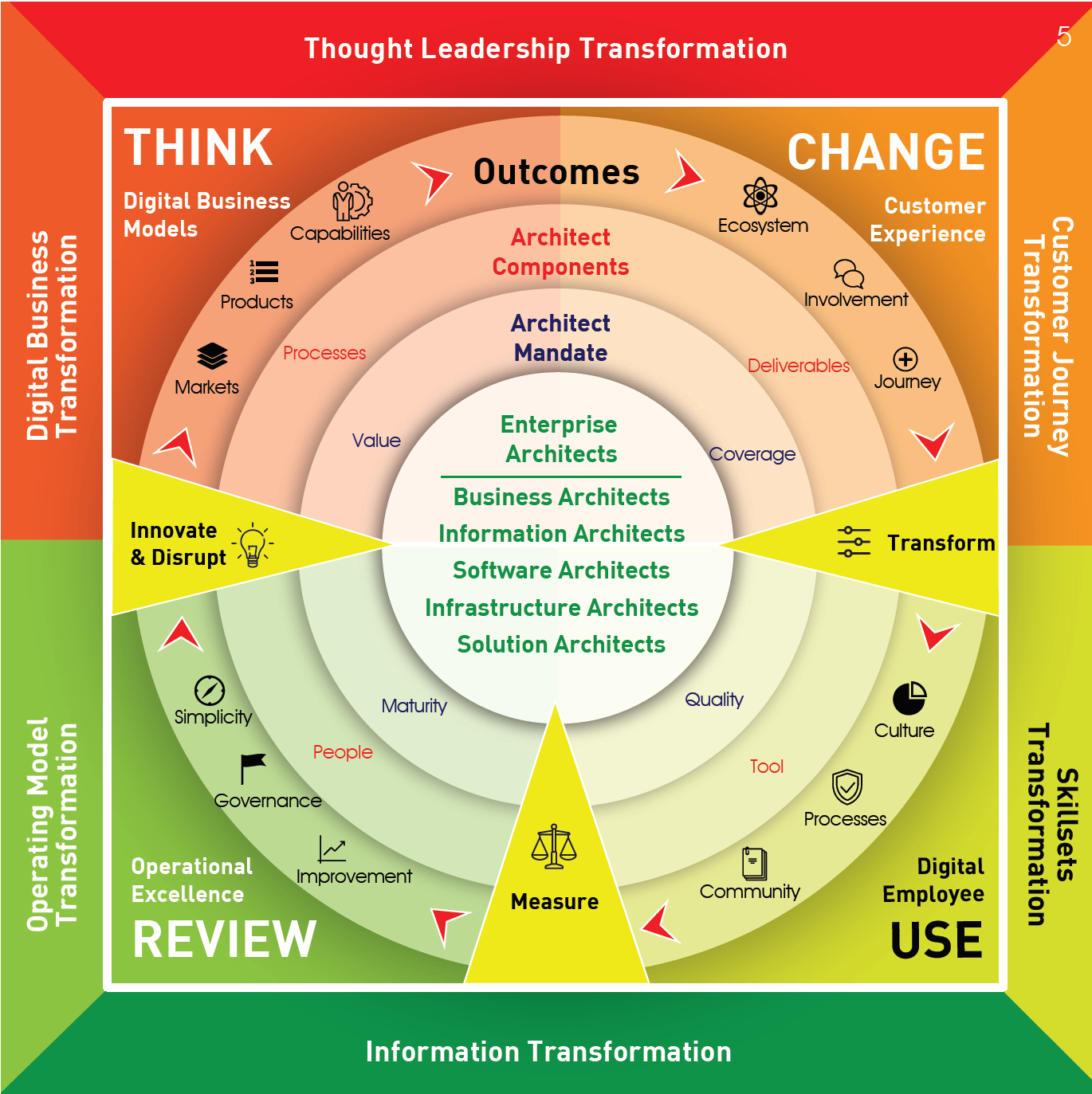Developing EA Engagement Model and Principles for Digital Initiatives
By Aaron Tan Dani
The Digital Enterprise Architecture practice needs to be a coordinated function that spans the full lifecycle. It needs to be managed and evolved over time, exhibit strong governance and control and deliver quantifiable value back to the business. The EA programs should immediately seek to define a simple, well understood architecture engagement model focused on innovation, strategic planning and transformation. As an
Enterprise Architect in a typical organisation, their day to day job will be interfacing and communicating with various stakeholders in both internal organisation and external parties like vendors, government, industry and regulatory bodies as depicted in the following figure:

1: Enterprise Architects’ Engagement Model
The following figure depicts how the Engagement Model shall be designed to drive the engagement to achieve the intended outcomes as defined by IASA, the Global IT Architecture Professional Body with the most recent development on its ITABoK (IT Architecture Body of Knowledge) that is describe in greater detail:

Figure 2: The IASA’s EA Engagement Model
For an Enterprise Architecture Office to be effective in their engagement model, the capacity of Enterprise Architect team members must be sufficient in order to achieve a healthy engagement. The question is how many we do need? Based on the research conducted by IASA through interviews with many organisation (corporate, service and product development industry) since 2002, IASA has concluded with the following EA profiles ratio as depicted in the following table that in general, the Enterprise Architect ratio is about 5 to 8 per cent (%) to IT staff in a typical organisation:
Table 1: Enterprise Architects Ratio to IT Staff As Recommended By IASA Research
|
EA Team Ratio
|
Corporation
|
Financial Services Industry Sector
|
Product Development
|
|
Enterprise Architects ratio to IT staff *IASA Research
|
5%
|
8%
|
6%
|
|
Effective Team Layout
|
Enterprise Architects per project
|
Enterprise Architects on all customer/ citizen engagements
|
EA as core to product management
|
With the healthy ratio number of Enterprise Architects being presence (Business Architects, Information Architects, Software Architects, Infrastructure Architects and Solution Architects), organisations should be able to drive various transformation program from Customer Journey Transformation, Skillsets Transformation, Information Transformation, Operating Model Transformation, Digital Business Transformation as well as Thought Leadership Transformation as depicted in the following diagram:

Figure 3: Enterprise Architects in various Driving Digital Transformation Initiatives
Developing the Architecture Principle
The EA principles established is used to ensure organisations are organised and designed based on the selection and adjustment as a whole in a structured set that collectively define and guide the EA implementation, from values through to actions and results. EA principles are related to architecture works that reflect consensus and govern the architecture process, affecting the development, maintenance, and implementation.
Each architecture principle will focus on business goals to drive key architecture implementation that provides a basis for decision-making processes throughout the EA implementation and they are also part of a key element in implementing a successful governance strategy.EA Principles are inter-related, and need to be applied as a set and must be considered in the context of "all other things being equal" and they are organised in four (4) categories as follows:
- Business Architecture principles
- Data Architecture principles
- Application Architecture principles
- Infrastructure Architecture principles
The EA’s principles are used to capture the fundamental truths for successful EA establishment and they are used in a number of different ways:
- As a decision framework in establishing relevant evaluation criteria, thus exerting strong influence on the selection of technology and solution architectures in managing the implementation compliance to the defined architecture.
- As drivers in assessing both existing IT systems and the future strategic portfolio, for compliance with the defined architectures in support of Bank Islam’s business goals and priorities.
- The Rationale statements highlight the value of the architecture to the enterprise, and therefore provides a basis for justifying architecture activities.
- As a decision framework in establishing relevant evaluation criteria, thus exerting strong influence on the selection of technology and solution architectures in managing the implementation compliance to the defined architecture.
- The Rationale statements highlight the value of the architecture to the enterprise, and therefore provides a basis for justifying architecture activities.
- The Implications statements provide an outline of the key tasks, resources, and potential costs to the enterprise of following the principle.
- It also supports the architecture governance activities in terms of:
- Providing a "back-stop" for the standard Architecture Compliance assessments where some interpretation is allowed or required.
- Supporting the decision to initiate a dispensation request where the implications of a particular architecture amendment cannot be resolved within local operating procedure.
EA has the potential to unblock the power of information by unifying the information silos in an enterprise that hinder various stakeholders from cooperating with each other. Through detailed EA Engagement Models and Principles, organisations will acquire the new digital capabilities with the potential to unblock within the organisations, allowing them to become more agile in managing digital disruptions and continuously developing new business capabilities to help realise realising its vision and missions through Digital Transformation.
Author: Aaron Tan Dani
President of Singapore Computer Society EA-Chapter [email protected]
Founder and Chairman of Iasa Asia Pacific [email protected]
Chief Architect of ATD Solution [email protected]
Related websites:
- Computer Society EA-Chapter: http://www.scs.org.sg/Chapter/ea-homepage
Join the EA activities in Singapore and learn how you can implement Digital-Business-driven EA in your organisation.
- IASA: www.iasaglobal.org
Learn more about ITABoK (IT Architecture Body of Knowledge) skillsets and about the roles, scopes and impacts of EA Specializations.
- ATD Solution: www.atdsolution.com
Acquire successful Digital Transformation adoption with ATD Enterprise Architecture consulting and training services.